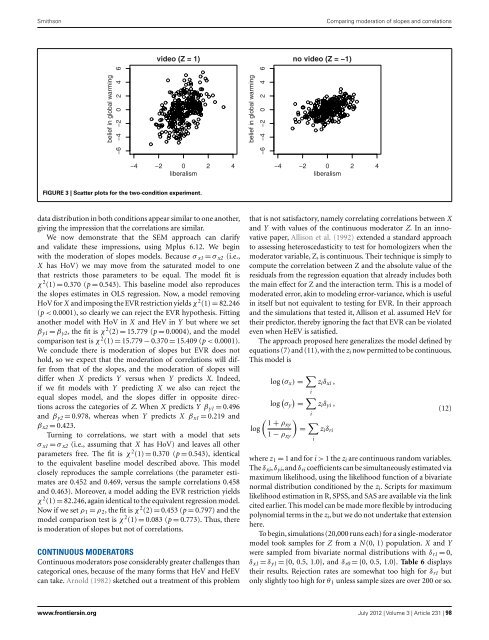Sweating the Small Stuff: Does data cleaning and testing ... - Frontiers
Sweating the Small Stuff: Does data cleaning and testing ... - Frontiers
Sweating the Small Stuff: Does data cleaning and testing ... - Frontiers
- No tags were found...
Create successful ePaper yourself
Turn your PDF publications into a flip-book with our unique Google optimized e-Paper software.
SmithsonComparing moderation of slopes <strong>and</strong> correlationsvideo (Z = 1)no video (Z = −1)belief in global warming−6 −4 −2 0 2 4 6belief in global warming−6 −4 −2 0 2 4 6−4 −2 0 2 4liberalism−4 −2 0 2 4liberalismFIGURE 3 | Scatter plots for <strong>the</strong> two-condition experiment.<strong>data</strong> distribution in both conditions appear similar to one ano<strong>the</strong>r,giving <strong>the</strong> impression that <strong>the</strong> correlations are similar.We now demonstrate that <strong>the</strong> SEM approach can clarify<strong>and</strong> validate <strong>the</strong>se impressions, using Mplus 6.12. We beginwith <strong>the</strong> moderation of slopes models. Because σ x1 = σ x2 (i.e.,X has HoV) we may move from <strong>the</strong> saturated model to onethat restricts those parameters to be equal. The model fit isχ 2 (1) = 0.370 (p = 0.543). This baseline model also reproduces<strong>the</strong> slopes estimates in OLS regression. Now, a model removingHoV for X <strong>and</strong> imposing <strong>the</strong> EVR restriction yields χ 2 (1) = 82.246(p < 0.0001), so clearly we can reject <strong>the</strong> EVR hypo<strong>the</strong>sis. Fittingano<strong>the</strong>r model with HoV in X <strong>and</strong> HeV in Y but where we setβ y1 = β y2 , <strong>the</strong> fit is χ 2 (2) = 15.779 (p = 0.0004), <strong>and</strong> <strong>the</strong> modelcomparison test is χ 2 (1) = 15.779 − 0.370 = 15.409 (p < 0.0001).We conclude <strong>the</strong>re is moderation of slopes but EVR does nothold, so we expect that <strong>the</strong> moderation of correlations will differfrom that of <strong>the</strong> slopes, <strong>and</strong> <strong>the</strong> moderation of slopes willdiffer when X predicts Y versus when Y predicts X. Indeed,if we fit models with Y predicting X we also can reject <strong>the</strong>equal slopes model, <strong>and</strong> <strong>the</strong> slopes differ in opposite directionsacross <strong>the</strong> categories of Z. When X predicts Y β y1 = 0.496<strong>and</strong> β y2 = 0.978, whereas when Y predicts X β x1 = 0.219 <strong>and</strong>β x2 = 0.423.Turning to correlations, we start with a model that setsσ x1 = σ x2 (i.e., assuming that X has HoV) <strong>and</strong> leaves all o<strong>the</strong>rparameters free. The fit is χ 2 (1) = 0.370 (p = 0.543), identicalto <strong>the</strong> equivalent baseline model described above. This modelclosely reproduces <strong>the</strong> sample correlations (<strong>the</strong> parameter estimatesare 0.452 <strong>and</strong> 0.469, versus <strong>the</strong> sample correlations 0.458<strong>and</strong> 0.463). Moreover, a model adding <strong>the</strong> EVR restriction yieldsχ 2 (1) = 82.246, again identical to <strong>the</strong> equivalent regression model.Now if we set ρ 1 = ρ 2 , <strong>the</strong> fit is χ 2 (2) = 0.453 (p = 0.797) <strong>and</strong> <strong>the</strong>model comparison test is χ 2 (1) = 0.083 (p = 0.773). Thus, <strong>the</strong>reis moderation of slopes but not of correlations.CONTINUOUS MODERATORSContinuous moderators pose considerably greater challenges thancategorical ones, because of <strong>the</strong> many forms that HeV <strong>and</strong> HeEVcan take. Arnold (1982) sketched out a treatment of this problemthat is not satisfactory, namely correlating correlations between X<strong>and</strong> Y with values of <strong>the</strong> continuous moderator Z. In an innovativepaper, Allison et al. (1992) extended a st<strong>and</strong>ard approachto assessing heteroscedasticity to test for homologizers when <strong>the</strong>moderator variable, Z, is continuous. Their technique is simply tocompute <strong>the</strong> correlation between Z <strong>and</strong> <strong>the</strong> absolute value of <strong>the</strong>residuals from <strong>the</strong> regression equation that already includes both<strong>the</strong> main effect for Z <strong>and</strong> <strong>the</strong> interaction term. This is a model ofmoderated error, akin to modeling error-variance, which is usefulin itself but not equivalent to <strong>testing</strong> for EVR. In <strong>the</strong>ir approach<strong>and</strong> <strong>the</strong> simulations that tested it, Allison et al. assumed HeV for<strong>the</strong>ir predictor, <strong>the</strong>reby ignoring <strong>the</strong> fact that EVR can be violatedeven when HeEV is satisfied.The approach proposed here generalizes <strong>the</strong> model defined byequations (7) <strong>and</strong> (11),with <strong>the</strong> z i now permitted to be continuous.This model islog (σ x ) = ∑ z i δ xi ,ilog ( ) ∑σ y = z i δ yi ,( ) 1 + ρxylog= ∑ 1 − ρ xyiiz i δ ri(12)where z 1 = 1 <strong>and</strong> for i > 1 <strong>the</strong> z i are continuous r<strong>and</strong>om variables.The δ xi ,δ yi , <strong>and</strong> δ ri coefficients can be simultaneously estimated viamaximum likelihood, using <strong>the</strong> likelihood function of a bivariatenormal distribution conditioned by <strong>the</strong> z i . Scripts for maximumlikelihood estimation in R, SPSS, <strong>and</strong> SAS are available via <strong>the</strong> linkcited earlier. This model can be made more flexible by introducingpolynomial terms in <strong>the</strong> z i , but we do not undertake that extensionhere.To begin, simulations (20,000 runs each) for a single-moderatormodel took samples for Z from a N (0, 1) population. X <strong>and</strong> Ywere sampled from bivariate normal distributions with δ r1 = 0,δ x1 = δ y1 = {0, 0.5, 1.0}, <strong>and</strong> δ r0 = {0, 0.5, 1.0}. Table 6 displays<strong>the</strong>ir results. Rejection rates are somewhat too high for δ r1 butonly slightly too high for θ 1 unless sample sizes are over 200 or so.www.frontiersin.org July 2012 | Volume 3 | Article 231 | 98














